Argentine cuisine
 |
| Part of a series on |
| Argentine cuisine |
|---|
| Regional cuisines |
|
| Ingredients and types of food |
|
| See also |
|
| This article is part of a series on the |
| Culture of Argentina |
|---|
 |
|
Arts & Literature |
|
Pastimes |
|
Argentina portal |
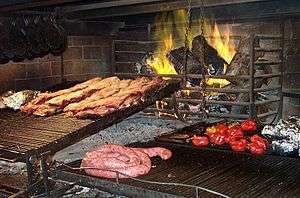
Argentine cuisine is described as a cultural blending of Indigenous, Mediterranean influences (such as those created by Italian and Spanish populations) within the wide scope of agricultural products that are abundant in the country. Argentine annual consumption of beef has averaged 100 kg (220 lbs) per capita,[1] approaching 180 kg (396 lbs) per capita during the 19th century; consumption averaged 67.7 kg (149 lbs) in 2007.[2] Beyond asado (the Argentine barbecue), no other dish more genuinely matches the national identity. Nevertheless, the country's vast area, and its cultural diversity, have led to a local cuisine of various dishes.[3][4] The great immigratory waves consequently imprinted a large influence in the Argentine cuisine, after all Argentina was the second country in the world with the most immigrants with 6.6 million, only second to the United States with 27 million, and ahead of other immigratory receptor countries such as Canada, Brazil, Australia, etc.[5][6]
Argentine people have a reputation for their love of eating.[3] Social gatherings are commonly centered on sharing a meal. Invitations to have dinner at home is generally viewed as a symbol of friendship, warmth, and integration. Sunday family lunch is considered the most significant meal of the week, whose highlights often include asado or pasta.[3]
Another feature of Argentine cuisine is the preparation of homemade food such as french fries, patties, and pasta to celebrate a special occasion, to meet friends, or to honor someone. The tradition of locally preparing food is passed down from generation to generation, and homemade food is also seen as a way to show affection.[3]
Argentine restaurants include a great variety of cuisines, prices, and flavors.[3] Large cities tend to host everything from high-end international cuisine, to bodegones (inexpensive traditional hidden taverns), less stylish restaurants, and bars and canteens offering a range of dishes at affordable prices.[3]
History
Native Americans lived in Argentina thousands of years before the European explorers arrived. Members of an Indian tribe in the southern part of Argentina were farmers who grew squash, melons, and sweet potatoes. Spanish settlers came to Argentina in 1536. Between 1853 and 1955, 6.6 million immigrants came to live in Argentina from diverse sources such as Europe, the Near and Middle East, Russia and Japan, contributing to the development of Argentine cuisine and making Argentina the second country with most immigrants only second to the United States.[5][6] Most of the immigrants were from Italy and Spain. The Italians introduced pizza, as well as a variety of pasta dishes, including spaghetti and lasagna. British, German, Jewish, and other immigrants also settled in Argentina, all bringing their styles of cooking and favorite foods with them. The British brought tea, starting the tradition of teatime. All of these cultures influenced the dishes of Argentina.[7]
Typical foods
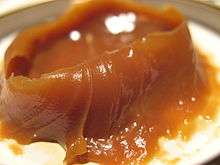
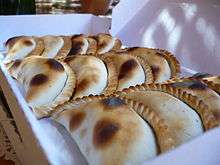
Most regions of Argentina are known for their beef-oriented diet. In Argentina the Spanish term,"Carne", which means meat, is assumed to be beef in Argentina. In other Spanish-speaking countries—such as Spain—the term is usually qualified with the type of animal, such as "carne de vaca" (beef), "carne de cordero" (lamb), etc.
Grilled meat from the asado (barbecue) is a staple, with steak and beef ribs especially common. The term asado itself refers to long strips of flank-cut beef ribs. Popular items such as Chorizo (pork sausage), morcilla (blood sausage), chinchulines (chitterlings), mollejas (sweetbread), and other parts of the animal are also enjoyed. In Patagonia, however, lamb and chivito (goat) are eaten more frequently than beef. Whole lambs and goats are traditionally cooked over an open fire in a technique known as asado a la estaca.
The most common condiment for asado is Chimichurri, a sauce of herbs, garlic and vinegar. Unlike other preparations, Argentines do not include chili in their version of chimichurri.
Breaded and fried meats — milanesas — are used as snacks, in sandwiches, or eaten warm with mashed potatoes — purée. Empanadas — small pastries of meat, cheese, sweet corn, and a hundred other fillings — are a common sight at parties and picnics, or as starters to a meal. A variation, the "empanada gallega" (Galician empanada), is a big, round meat pie made most commonly with tuna and mackerel ("caballa" in Spanish). Vegetables and salads are also eaten by Argentines; tomatoes, onions, lettuce, eggplants, squashes, and zucchini are common side dishes.
Italian staples, such as pizza and pasta, are eaten as commonly as beef. Fideos (noodles), tallarines (fettucine and tagliatelle), ñoquis (gnocchi), ravioles, and canelones (cannelloni) can be bought freshly made in many establishments in the larger cities. Italian-style ice cream is served in large parlours and even drive-through businesses.
In Chubut, the Welsh community is known for its teahouses, offering scones and torta galesa, which is rather like torta negra.
Sandwiches de miga are delicate sandwiches made with crustless buttered white bread, very thinly sliced cured meat, cheese, and lettuce. They are often purchased from entrepreneurial home cooks and may be eaten for a light evening meal.
A sweet paste, dulce de leche is another treasured national food, used to fill cakes and pancakes, spread over toasted bread for breakfast, or served with ice cream. Alfajores are shortbread cookies sandwiched together with chocolate and dulce de leche or a fruit paste. The "policeman's" or "truck driver's" sweet is cheese with quince paste or dulce de membrillo. Dulce de batata is made of sweet potato/yam: this with cheese is the Martín Fierro's sweet. Apples, pears, peaches, kiwifruits, avocados, and plums are major exports.
A traditional drink of Argentina is an infusion called mate (in Spanish, mate, with the accent on the first syllable [MAH-teh]). The name comes from the hollow gourd from which it is traditionally drunk. The mate (gourd) or other small cup is filled about three-quarters full with yerba mate, the dried leaves and twigs of the Ilex paraguariensis. The drink, which is rather bitter, is sipped through a metal or cane straw called a bombilla. Mate can be sweetened with sugar, or flavored with aromatic herbs or dried orange peel. Hot but not boiling water is poured into the gourd, drunk, then the mate is refilled. The mate is nearly full of leaves, so each refill only makes a small drink, but many refills are possible before the yerba is spent. In small gatherings it is traditional for one mate to be passed from person to person, filled by whoever has the kettle. It is customary not to thank the refiller routinely; a final gracias (thank you) implies that the drinker has had enough.[8] Drinking mate together is an important social ritual. Mate cocido is the same leaf, which rather than brewed is boiled and served, like tea, with milk and sugar to taste.
Other typical drinks include wine (sometimes with soda water added); tea and coffee are equally important. Quilmes is the national brand of pale lager, named after the town of Quilmes, Buenos Aires, where it was first produced.
Ingredients
Argentine Cuisine is heavily based on the growth of all kinds of cereals, grains, oil seeds, fruits and vegetables, since Argentina is a significantly large livestock and agricultural country. In the Mesopotamia waters the following river fish including silverside, surubi, dorado or boga clearly stand out.[3]
Meat products have been dominant in the country since the 16th century.[9] The country is regarded as a major beef, pork and poultry producing and consuming country. As a matter of fact, certain areas such as those located in the south are usually engaged in activities involving sheep and lamb breeding, and shellfish, crustaceans, molluscs and salmonides fishing.
The vast breeding activity involving any type of cattle has given rise to a very developed dairy industry that includes products like cow, sheep and camelide, cheese, dulce de leche and yogurts. Argentina can also be conceived as a great industry engaged in the production of dried fruits, olives, all types of oils and spices.[3]
When it comes to blending ingredients and readapating other latitude cuisines traditions, the almost unlimited source of raw materials above enables the existence of a great product versatility.[3]
Regional differences
Argentine cuisine is heavily influenced by its European roots and has regional variations. Asado, dulce de leche, empanadas, and yerba mate are found throughout Argentina. In many parts of the country, food is prepared differently and different kinds of foods are made; this includes to a smaller degree food from pre-Columbian times, as in the Northwest.
Central region and la Pampa
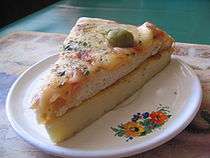
For long periods, urban areas such as Buenos Aires, Rosario, and Córdoba welcomed European immigrants, including, above all, those of Italian and Spanish descent. Nevertheless, there was also a migratory flow of German, Swiss, and Middle-Eastern immigrants arriving in Argentina. Among the countless changes this melting pot brought was the enrichment of the culinary art. Dishes such as pasta, pizza, pucheros (stews), croquetas (fritter)s, sauces, embutidos (sausages), and chicken and meat courses brought a wider scope of options to daily menus. Furthermore, the bread-making, dessert, pastry, and dairy industries have achieved considerable development in this region.
The above-mentioned dishes have developed a distinctively Argentine nuance. That is why, for example, Argentine pasta includes a wide variety of dishes ranging from spaghetti, fusiles (fusilli), ñoquis (gnocchi), ravioli, cintas (pasta ribbons), and lasagne to the Argentine-made sorrentinos, agnolottis (agnolotti), canelones (cannelloni), and fetuchines (fetuchini).
Pizza—made with very thin, and sometimes thick, high-rising doughs, with or without cheese, cooked in the oven or a la piedra (on a stone oven), and stuffed with numerous ingredients -— is a dish which can be found in nearly every corner of the country. Buenos Aires, Rosario, and Córdoba also serve it with fainá, which is a chick pea-flour dough placed over the piece of pizza. People say that what makes the Argentine pizza unique is the blending of Italian and Spanish cultures. At the turn of the 19th century, immigrants from Naples and Genoa opened the first pizza bars, though Spanish residents subsequently owned most of the pizza businesses.
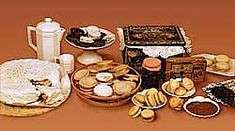
Bread products are consumed all around the country. The deeply rooted bread, pastry, and dessert-making tradition derives from blending the above nationalities' products. Bakeries sell not only a wide scope of breads, cookies, and cakes, but also pastries. The latter resembles a sort of roll pastry whose main dough ingredient is either butter or fat and which may be simple or stuffed with dulce de leche, milk, jam, crema pastelera, or quince or apple jelly, among other fillings. The most popular type of pastry is said to be that of medialunas, based upon French croissants. Furthermore, sandwiches de miga are another type of bread products; they are made only with thin layers of white bread (generally referred to as crustless bread) and stuffed with food items ranging from ham and cheese to other more sophisticated combinations such as raw ham, tomatoes, olives, hard boiled eggs, tuna, lettuce, red pepper, and the like.
Desserts and sweets are usually stuffed or covered with dulce de leche. The latter can be eaten alone or on top of cakes, alfajores, panqueques (creppes), and pastries, or as a topping spread over flan. Chantilly cream is widely consumed and used in preparing sweets and desserts. Additionally, cakes, sponge cakes, and puddings are very popular dishes. Italian ice-creams in this region also achieved a significant degree of development by adding local flavors that somehow preserved the local spirit involved in their preparation.
Although asado is eaten all over the country, its origin may be traced back to the Pampas. It entails manifold types of meat, which are generally eaten as follows: achuras (offal, or the cow's inner parts), morcilla (blood sausage), and sometimes also a provoleta (a piece of provolone cheese cooked on the grill with oregano) are eaten first. Then comes the choripán (a kind of spiced sausage made with pork or lamb and placed between two slices of bread), and lastly meat such as asado de tira, vacío (hindquarter), lomo (tenderloin), colita de cuadril (rump), matambre (rolled stuffed steak cut into slices and served cold), entraña (innards); the list is never-ending. It is quite common to eat and enjoy a dish known as cabrito al asador (roast kid or goat) in the province of Córdoba.
Northwest and Cuyo
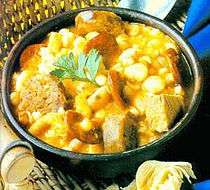
This region is regarded as perhaps the one most influenced by native Indians, and its foods are closely linked to the Andean-Incan tradition. When preparing regional dishes, potatoes and corn or wheat are almost always used, including quinoa (a cereal typically used in Incan cuisine), peppers, squashes and tomatoes. The most celebrated dishes are humita and tamal, in which the corn husk is stuffed with the corn filling itself, seasonings or meat.
This region is the most suitable to taste empanadas, particularly those stuffed with meat and offering different types of tempting varieties such as the meat empanada, salteña also filled with potatoes, or the empanada tucumana, which is stuffed with matambre and cut with a knife, or empanadas made with cheese. Empanadas are individual sized and closed savoury pastries which may be fried or baked in the oven and are generally eaten with the hands.
Stews such as locro, carbonada, pollo al disco, and cazuelas (casseroles) are also typical dishes characterizing this region, which also include pumpkin or potato pudding stuffed with meat.
Mesopotamia
The humid and verdant area of north-east Argentina known as Mesopotamia, comprising the provinces of Misiones, Entre Ríos and Corrientes. is another area influenced by native Indians, particularly by the Guaraní tribe. Abounding in rivers and shores, it offers a wide diversity of fish species, such as dorado, pacú, surubi, boga and silverside.
Widely grown in this area, cassava is typically included in the region's dishes, as are other components of meals, such as the chipá (a cassava and cheese bread), which originally came from Paraguay. However, in this area Cassava is cooked alone too, boiled or fried, often as a side dish for asado and empanadas. Sopa Paraguaya and Chipá Guazu (also called Tarta de Choclo) are also commonly eaten and are made with corn. Chipá from Cassava is often eaten during breakfast with yerba mate, prepared with hot water, or with café con leche. Sopa Paraguaya and Tarta de Choclo are eaten for lunch or dinner. As regards to products made with sugar, Papaya (mamón in Argentine Spanish) jam is typical of the province of Corrientes.
The principal product of this region is certainly yerba mate. Consumed countrywide, this product features a peculiarity of its own in this area: it is not only prepared with hot water, but, driven by the region's high temperatures, it is common to see it prepared with cold water as well, in which case the beverage is known as tereré.
Patagonia
Foods produced in the large southern region of Patagonia include fish and seafood from the sea and rivers, and the products of the sheep widely farmed there.
Marine species such as salmon, spider crabs, squid and other shellfish and molluscs may be caught in the Atlantic Ocean. There are trout in the rivers.
The many berries grown in the area include cherries, bilberries, strawberries, rosa mosqueta and elders, which are made into jams.
The Northern and Central European settlements in this region have built up large-scale production of chocolate and its by-products. Viennese and German cuisine and pastries are also typically associated with this region.
Mutton and lamb, together with wild boar and venison tend to make up the region's meat-based dishes. Also typical of southern region are smoked products, including salmon, stag, wild boar, and pheasant.
Patagonia has been profoundly influenced by the tribes living there since long before Europeans arrived, in particular, the Mapuches and the Araucanos. A typical dish prepared by the latter is the curanto (a term meaning "hot stone"). Its preparation involves making a fire in a hole about 150 cm deep in the ground, and heating stones in it. A bed of nalca or maqui leaves is arranged on top of the stones, and ingredients are added in turn on top. Ingredients vary, but may include beef, lamb, pork, chicken, Argentine chorizos (pork sausages), potatoes, sweet potatoes, apples and holed squashes filled with cheese, cream and peas. The food is covered with leaves and damp pieces of cloth to keep the heat in, and covered with plenty of soil.
Alcoholic beverages
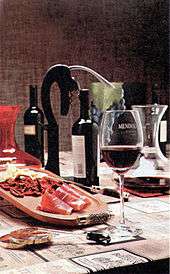

Though wine (vino) has traditionally been the most popular alcoholic beverage in Argentina, beer (cerveza; the Italian birra is frequently used) in recent decades has competed with wine in popularity. Breweries appeared in Argentina at the end of the 1860s, started by Alsatian colonists. The first were nearly all in the downtown of Buenos Aires (el égido de la Ciudad Autónoma de Buenos Aires), and soon Polish brewers began industrial production of beer: San Carlos in the province of Santa Fe, Río Segundo and Córdoba in the province of Córdoba, Quilmes and Llavallol on the outskirts of La Plata (in Buenos Aires Province), San Miguel de Tucumán in the province of Tucumán and on the outskirts of the cities of Mendoza and Salta.
The local consumption of beer has risen dramatically in the last generation: Argentines consumed 233 million liters in 1980 and 1.57 billion in 2007 (40 liters per capita).[10] Outpacing that of wine since 2001, the growing production and consumption of beer has supported the existence of related events, for example beer festivals called Oktoberfests or "Fiestas de la Cerveza" in locations that have a significant German population (Villa General Belgrano in Córdoba, San Carlos and Esperanza in the province of Santa Fe, etc.). Such celebrations copy, in an Argentine manner, Munich's Oktoberfest, and similarly are tourist attractions. However, the presence of a vigorous population of Celtic lineage, principally of Irish origin, has supported the creation of other celebrations of beer, often for marketing purposes, such as Saint Patrick's Day (Día de San Patricio), patron of Ireland, which is celebrated with abundant libations.
The consumption of alcoholic beverages in Argentina is similar to that of the United States and somewhat lower than the Western European average.[11] Argentines enjoy a variety of alcoholic beverages and Argentina can boast a varied array of elaboraciones, whether industrial or artisanal. Besides beer and wine, Argentines frequently drink cider (here again, the heritage comes from Spain and Italy, more precisely from Asturias and Campania). Cider is the most popular beverage of the middle and lower economic classes at Christmas and New Year (the upper classes proverbially preferring to celebrate with locally produced champagne, although real old-line "creole" aristocrats will still drink cider, which is much more traditional).
Other widely consumed spirits are aguardiente (firewater) made from sugar cane, known as caña quemada ("burnt cane") or, simply, 'caña' ("cane").[12] A folkloric note about caña quemada: until June 21 it is traditional to drink caña quemada with ruda macho (a variant of common rue), it is supposed that this mixture prevents the flu and other illnesses. Caña competes, mainly in rural areas, with gin ("ginebra"—as in the Dutch kind of gin.)
There are many artisanally produced liqueurs (distilled, flavored alcoholic beverages) in Argentina, for example those flavored with orange, egg, anise, coffee, cherry and, inevitably, dulce de leche. The Hesperidina is a type of liqueur made from orange peels, invented in Argentina around 1890. One may also encounter chitronchelo or (in Italian) citroncello, based on lemon. This beverage arrived with immigrants from the Mezzogiorno, and is produced both artisanally and industrially (for example, at Mar del Plata).
Non-alcoholic specialties

Argentines enjoy a wide variety of non-alcoholic infusions (although now and then both "families" are mixed; the yerbiao for example, is mate mixed with caña or gin). Among these, mate has long been the most widely enjoyed; in 2006, over 700,000 metric tons were harvested in Argentina, mostly for domestic consumption.[14]
The fact that mate is so prevalent in the Southern Cone, however, should not necessarily make visitors think that other infusions are rare in the region; in Argentina especially, given the strong European cultural imprint, the consumption of coffee is very common (141 cups per capita, annually).[13] Chocolate infusions are also popular (the eating of chocolate is a Spanish influence, although the plant originated in Mesoamerica). This consumption grows during autumn and winter, or in the cold regions of the country; there are two dates where consumption of chocolate infusions is traditional in the primary educational centres: 25 May and 9 July, that is, the two national dates of Argentina.
English cultural influence (reinforced at the end of the 19th century and beginnings of the 20th by British contacts with the Far East) has also made the consumption of tea very common.
Medicinal herbs are common in the whole country; among the most popular are: chamomile, lanceleaf, boldo, poleo, peperina, carqueja, thyme, canchalagua, rue (macho and hembra, that is, "male" and "female"), mallow, rosemary, passion flower, bira bira, palán palán, muña muña, to mention only the main ones. Many of these herbs are also used in apéritifs and bitters, whether alcoholic or not.
Popular short-order dishes
Common restoranes or restaurantes and rotiserias (grill restaurants) nearly anywhere in Argentina today serve (into the small hours) quickly prepared meals that in the course of the 20th century came to be known as minutas, "short-order dishes." Some of the dishes included in the category of minutas are milanesas, churrascos, bifes (beefsteaks), escalopes, tallarines, ravioles (ravioli), ñoquis (gnocchi), although some are very typical of locations that sell food: "bifes" and "milanesas" are served "a caballo" ("on horseback", with fried egg on top), "milanesa completa" (a milanesa with two fried eggs and French fries), "revuelto Gramajo", "colchón de arvejas" (an omelette made with peas), "suprema de pollo" (chicken supreme, usually breaded as a milanesa), matambres, "lengua a la vinagreta" (pickled tongue), and "sandwiches" (sandwiches de miga) are made with sliced white bread, rather than, say, rolls.
The most common sandwiches are those made of milanesa, baked ham and cheese, 'pan de miga, toast, pebetes, panchos (hot dogs), choripanes, morcipanes, etc.; from Montevideo comes a different species of sandwich called the chivito, even though it contains no goat meat.
Picadas, which are consumed at home or in bars, cafés, "cafetines" and "bodegones" are also popular; they consist of an ensemble of plates containing cubes of cheese (typically from Mar del Plata or Chubut), pieces of salame, olives in brine, french fries, maníes (peanuts), etc.; picadas are eaten accompanied by an alcoholic beverage ("fernet", beer, wine with soda, to give some common examples).
The people of Argentina greatly enjoy helado (ice cream or sorbet). In Spanish colonial times a type of sorbet was made from hail or snow.
-

A picada, the Italian-influenced between-meals standby
Eating habits
In most parts of Argentina, lunch is the largest meal of the day. Excluding the largest cities, such as Buenos Aires, most towns close for lunch time. This is when most people return home to enjoy a large meal. Traditional lunches in Argentina are long and well developed. As such, it's common to not eat dinner until 9 at night.
See also
References
- ↑ National Geographic Magazine. March 1958.
- ↑ http://www.comex.infobaeprofesional.com/notas/62697.html
- 1 2 3 4 5 6 7 8 9 "Argentina - Tourism - Gastronomy". 2012-03-23. Archived from the original on March 23, 2012. Retrieved 2016-02-26.
- ↑ "Cuisine of Argentina and Chile". About.com Travel. Retrieved 2016-02-26.
- 1 2
- 1 2
- ↑ "Food in Argentina" - Food in Every Country Julia
- ↑ La Nación newspaper: ¿Se toma un mate? (Segunda parte) Source for everything about mate, including terminal "gracias". (Spanish)
- ↑ Edelstein, Sari (2010). Food, Cuisine, and Cultural Competency for Culinary, Hospitality, and Nutrition Professionals. Jones & Bartlett Publishers. ISBN 978-0763759650. Retrieved 19 March 2014.
- ↑ "Programación Macroeconómica". www.mecon.gov.ar. Retrieved 2016-02-26.
- ↑ http://www.who.int/substance_abuse/publications/global_status_report_2004_overview.pdf
- ↑ Although "caña" in this sense is really derived from "cognac" and the term was traditionally used in old Argentina for any brandy, but especially for peach brandy, caña de durazno.
- 1 2 El negocio del café en la Argentina
- ↑ "INDEC: Instituto nacional de estadistica y censos de la Republica Argentina". www.indec.mecon.ar. Retrieved 2016-02-26.
External links
| Wikimedia Commons has media related to Cuisine of Argentina. |
| Wikimedia Commons has media related to Wines of Argentina. |
- SaltShaker - Blog on Buenos Aires "food, drink, and life".
- Pick Up the Fork - Fun guide to Buenos Aires' food, restaurant and bar scene
- Argentina on two steaks a day
- Cocina Pop - Typical Argentine recipes, with videos.